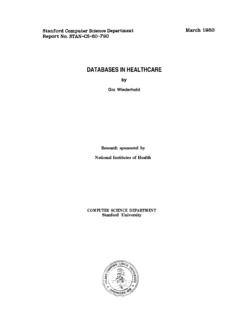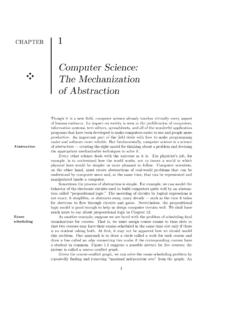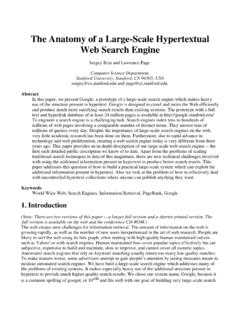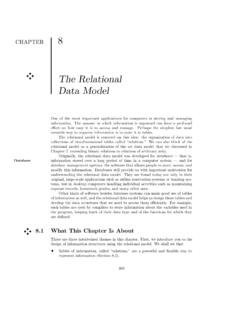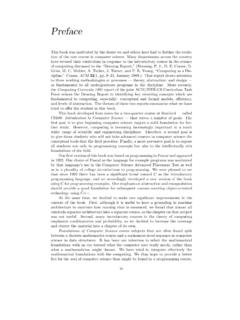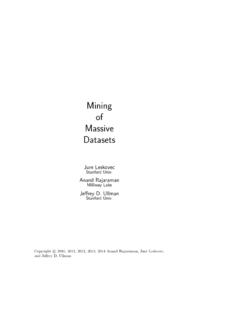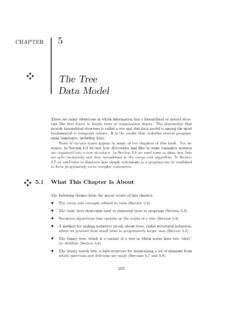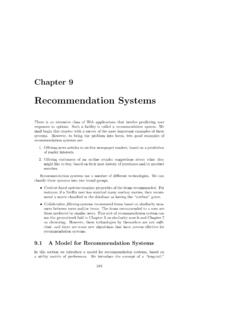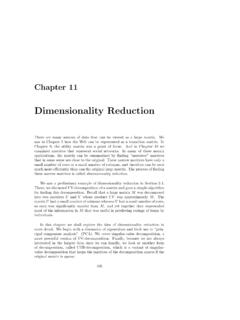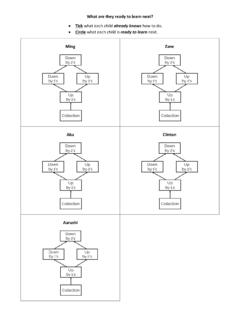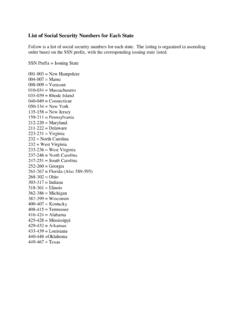Transcription of Combinatorics and Probability - Stanford University
1 CHAPTER 4.. Combinatorics .. and Probability In computer science we frequently need to count things and measure the likelihood of events. The science of counting is captured by a branch of mathematics called Combinatorics . The concepts that surround attempts to measure the likelihood of events are embodied in a field called Probability theory. This chapter introduces the rudiments of these two fields. We shall learn how to answer questions such as how many execution paths are there in a program, or what is the likelihood of occurrence of a given path? .. What This Chapter Is About We shall study Combinatorics , or counting, by presenting a sequence of increas- ingly more complex situations, each of which is represented by a simple paradigm problem. For each problem, we derive a formula that lets us determine the number of possible outcomes. The problems we study are: Counting assignments (Section ). The paradigm problem is how many ways can we paint a row of n houses, each in any of k colors.
2 Counting permutations (Section ). The paradigm problem here is to deter- mine the number of different orderings for n distinct items. Counting ordered selections (Section ), that is, the number of ways to pick k things out of n and arrange the k things in order. The paradigm problem is counting the number of ways different horses can win, place, and show in a horse race. Counting the combinations of m things out of n (Section ), that is, the selection of m from n distinct objects, without regard to the order of the selected objects. The paradigm problem is counting the number of possible poker hands. 156. SEC. COUNTING ASSIGNMENTS 157. Counting permutations with some identical items (Section ). The paradigm problem is counting the number of anagrams of a word that may have some letters appearing more than once. Counting the number of ways objects, some of which may be identical, can be distributed among bins (Section ).
3 The paradigm problem is counting the number of ways of distributing fruits to children. In the second half of this chapter we discuss Probability theory, covering the follow- ing topics: Basic concepts: Probability spaces, experiments, events, probabilities of events. Conditional probabilities and independence of events. These concepts help us think about how observation of the outcome of one experiment, , the drawing of a card, influences the Probability of future events. Probabilistic reasoning and ways that we can estimate probabilities of com- binations of events from limited data about the probabilities and conditional probabilities of events. We also discuss some applications of Probability theory to computing, including systems for making likely inferences from data and a class of useful algorithms that work with high Probability but are not guaranteed to work all the time.. Counting Assignments One of the simplest but most important counting problems deals with a list of items, to each of which we must assign one of a fixed set of values.
4 We need to determine how many different assignments of values to items are possible. Example A typical example is suggested by Fig. , where we have four houses in a row, and we may paint each in one of three colors: red, green, or blue. Here, the houses are the items mentioned above, and the colors are the values.. Figure shows one possible assignment of colors, in which the first house is painted red, the second and fourth blue, and the third green. Red Blue Green Blue Fig. One assignment of colors to houses. To answer the question, How many different assignments are there? we first need to define what we mean by an assignment. In this case, an assignment is a list of four values, in which each value is chosen from one of the three colors red, green, or blue. We shall represent these colors by the letters R, G, and B. Two such lists are different if and only if they differ in at least one position. 158 Combinatorics AND Probability .
5 In the example of houses and colors, we can choose any of three colors for the first house. Whatever color we choose for the first house, there are three colors in which to paint the second house. There are thus nine different ways to paint the first two houses, corresponding to the nine different pairs of letters, each letter chosen from R, G, and B. Similarly, for each of the nine assignments of colors to the first two houses, we may select a color for the third house in three possible ways. Thus, there are 9 3 = 27 ways to paint the first three houses. Finally, each of these 27. assignments can be extended to the fourth house in 3 different ways, giving a total of 27 3 = 81 assignments of colors to the houses.. The Rule for Counting Assignments We can extend the above example. In the general setting, we have a list of n items, such as the houses in Example There is also a set of k values, such as the colors in Example , any one of which can be assigned to an item.
6 An Assignment assignment is a list of n values (v1 , v2 , .. , vn ). each of v1 , v2 , .. , vn is chosen to be one of the k values. This assignment assigns the value vi to the ith item, for i = 1, 2, .. , n. There are k n different assignments when there are n items and each item is to be assigned one of k values. For instance, in Example we had n = 4 items, the houses, and k = 3 values, the colors. We calculated that there were 81 different assignments. Note that 34 = 81. We can prove the general rule by an induction on n. STATEMENT S(n): The number of ways to assign any one of k values to each of n items is k n . BASIS. The basis is n = 1. If there is one item, we can choose any of the k values for it. Thus there are k different assignments. Since k 1 = k, the basis is proved. INDUCTION. Suppose the statement S(n) is true, and consider S(n + 1), the statement that there are k n+1 ways to assign one of k values to each of n + 1 items.
7 We may break any such assignment into a choice of value for the first item and, for each choice of first value, an assignment of values to the remaining n items. There are k choices of value for the first item. For each such choice, by the inductive hypothesis there are k n assignments of values to the remaining n items. The total number of assignments is thus k k n , or k n+1 . We have thus proved S(n + 1) and completed the induction. Figure suggests this selection of first value and the associated choices of assignment for the remaining items in the case that n + 1 = 4 and k = 3, using as a concrete example the four houses and three colors of Example There, we assume by the inductive hypothesis that there are 27 assignments of three colors to three houses. SEC. COUNTING ASSIGNMENTS 159. First house Other three houses Red 27. Assignments Green 27. Assignments Blue 27. Assignments Fig. The number of ways to paint 4 houses using 3 colors.
8 Counting Bit Strings In computer systems, we frequently encounter strings of 0's and 1's, and these strings often are used as the names of objects. For example, we may purchase a computer with 64 megabytes of main memory. each of the bytes has a name, Bit and that name is a sequence of 26 bits, each of which is either a 0 or 1. The string of 0's and 1's representing the name is called a bit string. Why 26 bits for a 64-megabyte memory? The answer lies in an assignment- counting problem. When we count the number of bit strings of length n, we may think of the items as the positions of the string, each of which may hold a 0 or a 1. The values are thus 0 and 1. Since there are two values, we have k = 2, and the number of assignments of 2 values to each of n items is 2n . If n = 26 that is, we consider bit strings of length 26 there are 226 possible strings. The exact value of 226 is 67,108,864. In computer parlance, this number is thought of as 64 million, although obviously the true number is about 5% higher.
9 The box about powers of 2 tells us a little about the subject and tries to explain the general rules involved in naming the powers of 2. EXERCISES. : In how many ways can we paint a) Three houses, each in any of four colors b) Five houses, each in any of five colors c) Two houses, each in any of ten colors : Suppose a computer password consists of eight to ten letters and/or digits. How many different possible passwords are there? Remember that an upper-case letter is different from a lower-case one. *: Consider the function f in Fig. How many different values can f return? 160 Combinatorics AND Probability . int f(int x). {. int n;. n = 1;. if (x%2 == 0) n *= 2;. if (x%3 == 0) n *= 3;. if (x%5 == 0) n *= 5;. if (x%7 == 0) n *= 7;. if (x%11 == 0) n *= 11;. if (x%13 == 0) n *= 13;. if (x%17 == 0) n *= 17;. if (x%19 == 0) n *= 19;. return n;. }. Fig. Function f. : In the game of Hollywood squares, X's and O's may be placed in any of the nine squares of a tic-tac-toe board (a 3 3 matrix) in any combination ( , unlike ordinary tic-tac-toe, it is not necessary that X's and O's be placed alternately, so, for example, all the squares could wind up with X's).
10 Squares may also be blank, , not containing either an X or and O. How many different boards are there? : How many different strings of length n can be formed from the ten digits? A digit may appear any number of times in the string or not at all. : How many different strings of length n can be formed from the 26 lower-case letters? A letter may appear any number of times or not at all. : Convert the following into K's, M's, G's, T's, or P's, according to the rules of the box in Section : (a) 213 (b) 217 (c) 224 (d) 238 (e) 245 (f) 259 . *: Convert the following powers of 10 into approximate powers of 2: (a) 1012. (b) 1018 (c) 1099 .. Counting Permutations In this section we shall address another fundamental counting problem: Given n distinct objects, in how many different ways can we order those objects in a line? Such an ordering is called a permutation of the objects. We shall let (n) stand for the number of permutations of n objects.

